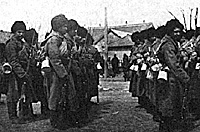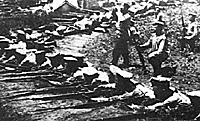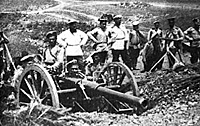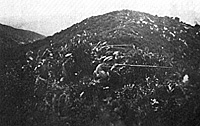RUSSIAN INFANTRY
 The Russian infantry again proved what the world already understood;
that it was obstinately brave, blindly obedient, and possessed great physical
endurance. However, these laudable qualities did not bring victory to the
soldiers of the Tsar. It was not the Russian infantry that failed the leaders
during the war, but it was the leaders that failed the infantry. The Russian
soldier demonstrated time after time that he was the equal of his Japanese
opponent.
The Russian infantry again proved what the world already understood;
that it was obstinately brave, blindly obedient, and possessed great physical
endurance. However, these laudable qualities did not bring victory to the
soldiers of the Tsar. It was not the Russian infantry that failed the leaders
during the war, but it was the leaders that failed the infantry. The Russian
soldier demonstrated time after time that he was the equal of his Japanese
opponent.
For their war in Manchuria, the Russians employed four types of infantry units; European, Siberian, East Siberian, and Rifles. These units all shared the same battalion organization, each consisting of four rifle companies, a scout detachment, and a headquarters staff. The war strength of the East Siberian companies was normally 220 rifles, which differed from the other three types of units which had 235 rifles. The scout detachments varied in strength from 40-60 men. These detachments could either be mounted or dismounted infantry, normally depending on the availability of horses.
The regiments' differences were based on their place of origin. The East Siberian regiments were the regular troops stationed in the Far East at the war's outbreak. The Siberian regiments were formed from reservists recalled to the colors who lived in Siberia and the Maritime Provinces. The European and Rifle regiments that mobilized for the war were drawn from the regular army stationed in western Russia. The Rifle regiments, as their name implies, were trained and used as light infantry to support the European army corps. Though the Rifles were reputed to be better marksmen than the regular infantry, the reality was that there was little difference between the two.
These differences in origin also influenced the regimental organization of these units. The war found the East Siberian regiments in transition from a two to a three battalion organization. This was an attempt to increase the army's strength prior to the conflict without seeming to escalate the situation. The European and Siberian regiments each had four battalions, the normal number for a Russian regiment. The Rifle regiments were organized with only two battalions, reflecting their lineage from the Jager regiments of earlier periods.
 The European, Siberian, and East Siberian regiments were formed into
divisions. Two regiments comprised a brigade, with two brigades per division.
The Rifle regiments formed independent brigades, with each brigade consisting
of four regiments.
The European, Siberian, and East Siberian regiments were formed into
divisions. Two regiments comprised a brigade, with two brigades per division.
The Rifle regiments formed independent brigades, with each brigade consisting
of four regiments.
Many observers during the war stated that the Russian infantry man was inferior to his Japanese counterpart. The reality was that, in most cases, the Russian performed equally well. The difference between the two infantry's abilities reflected the quality of leadership. What the wargamer must understand is that the war was a total effort for Japan, while it was not for Russia. Japan sent her best soldiers (in fact, all of her soldiers) to her armies in Manchuria. Russia never fully mobilized her army during the war. Only nine corps, out of the 30 corps available in Europe, were sent to the Far East. Additionally, Russia did not mobilize her army in accordance to her prewar plans. Instead of mobilizing all her 1st class reservists across the nation to bring the regiments to war strength, the Tsar only mobilized selected provinces. To meet the total numbers required, the 2nd and 3rd class reservists in these provinces were also mobilized to fill the ranks of the regiments marching to war. So, instead of regiments filled with active soldiers and ones recently released from the colors, 40 year old men who had not handled a rifle for 20 years were sent to serve in Manchuria.
RUSSIAN CAVALRY
 The Russians enjoyed a decisive advantage in cavalry throughout the
war in Manchuria. The fact that their cavalry did not become the means
of battlefield victory is explained by the ineffective Russian system of
mobilization, the limitations of the Trans Siberian railway and the army's
misplaced belief in the battlefield effectiveness of the Cossack cavalry.
The better use of the Russian cavalry provides the period with many "what
ifs".
The Russians enjoyed a decisive advantage in cavalry throughout the
war in Manchuria. The fact that their cavalry did not become the means
of battlefield victory is explained by the ineffective Russian system of
mobilization, the limitations of the Trans Siberian railway and the army's
misplaced belief in the battlefield effectiveness of the Cossack cavalry.
The better use of the Russian cavalry provides the period with many "what
ifs".
The Russians employed two types of cavalry in Manchuria, dragoons and Cossacks. Each dragoon regiment consisted of six squadrons, with 145 sabers per squadron.
 The Cossacks, the cavalry equivalent of the infantry reserve
regiments, were similarly organized, with the squadrons called sotnias.
As with her infantry, Russia did not deploy much of her excellent cavalry
from Europe, but relied on the Cossacks to fight the war. Only three regiments
of dragoons from the approximately Fifty cavalry regiments available were
deployed to Manchuria.
The Cossacks, the cavalry equivalent of the infantry reserve
regiments, were similarly organized, with the squadrons called sotnias.
As with her infantry, Russia did not deploy much of her excellent cavalry
from Europe, but relied on the Cossacks to fight the war. Only three regiments
of dragoons from the approximately Fifty cavalry regiments available were
deployed to Manchuria.
It is interesting to note that these three regiments gave excellent service during the war, The Russian reliance on the Cossack cavalry did ease the logistical problem of supporting a large cavalry force 5,000 miles away in Manchuria. Unfortunately, the problem with this approach was that the Cossacks were poorly trained. Though the Russians possessed an incredible 6 to 1 superiority in cavalry, their cavalry achieved little on the battlefield.
RUSSIAN ARTILLERY
 When the war began, the entire Russian artillery arm was re-arming with
a new field piece. The East Siberian artillery was changing from the 1892
model breechloader to the 1900 model Putilow at the start of the war, while
the units arriving from Europe were already equipped with the new gun.
The Putilow was a great equipment improvement for the Russian gunners.
It fired a larger round, had greater range, and doubled the rate of fire
of the model 1892. The effectiveness of the new gun was not realized in
the First battles due to the lack of training. Despite the fact the gun
was not a true quick-firer, the Putilow came to dominate the Japanese artillery
during the course of the war.
When the war began, the entire Russian artillery arm was re-arming with
a new field piece. The East Siberian artillery was changing from the 1892
model breechloader to the 1900 model Putilow at the start of the war, while
the units arriving from Europe were already equipped with the new gun.
The Putilow was a great equipment improvement for the Russian gunners.
It fired a larger round, had greater range, and doubled the rate of fire
of the model 1892. The effectiveness of the new gun was not realized in
the First battles due to the lack of training. Despite the fact the gun
was not a true quick-firer, the Putilow came to dominate the Japanese artillery
during the course of the war.
A Russian field battery consisted of eight guns. These batteries were organized into artillery brigades, with one brigade assigned to each infantry division. Here the organization becomes confusing. The number of batteries in each artillery brigade varied, based on whether the division was European, Siberian, East Siberian or a Rifle brigade. The organization of the European artillery was dictated at the corps level and will be discussed below. A Siberian or East Siberian division had four batteries in its artillery brigade while a Rifle artillery brigade possessed three batteries. The artillery brigades were numbered as their assigned parent units.
Horse artillery accompanied the cavalry during the Russo-Japanese War. The horse artillery was equipped with the same gun as the field artillery. A horse battery was assigned six guns, and, normally, two batteries (totaling twelve guns) were assigned to each cavalry division.
The Russians, like the Japanese, employed many makes of 12 heavy artillery. The number of guns in each battery varied, depending on the make of the guns, and their availability. The Russians entered the war lacking modern, heavy artillery (a problem that continued to plague them in the First World War). Most of their heavy artillery was converted naval ordnance and outdated pieces left over from earlier wars. The Russians never felt the need to change to artillery capable of blasting a defending enemy's fortifications due to the Japanese propensity of constant aggressive offense. Hence, the number of heavy batteries was limited, and the field gun was the most numerous artillery weapon on the battlefield.
HIGHER ORGANIZATIONS
The Russian infantry division lacked many of the refinements of the Japanese organization. A Russian infantry division consisted of two infantry brigades, an artillery brigade and four supply columns. It lacked many of the refinements that its Japanese counterpart possessed, and depended on its parent corps for support. The infantry corps was the basic fighting unit of the Russian army.
A corps consisted of two infantry divisions, a sapper battalion, a pontoon company, and a signal company. The corps normally possessed a cavalry division, but in Manchuria the cavalry component varied in size from nothing to a division. The sapper battalions provided support to the corps to construction of field fortifications and for the assault on enemy positions. The pontoon company provided the bridging capability and heavy construction for the corps. Some divisions were assigned a machine gun company. This company was organized like an artillery battery and had four machine guns.
Remember the aforementioned artillery organization for the European
divisions? For the European divisions, it was the corps structure that
guided the artillery organization. In a European corps, the rule of thumb
was that the corps would have fourteen batteries. This meant that one artillery
brigade in one division would have eight batteries and the other artillery
brigade in the other division would have six. One must use an OB to determine
which European division had what size artillery brigade. This difference
tended to disappear as artillery losses caused the Russians to cross-level
pieces between brigades. By the Battle of San-de-Pu in January, 1905 ,
all the artillery brigades of the European divisions consisted of six batteries.
The cavalry was formed into brigades, with two regiments in a brigade.
This could, and often did, vary with the Cossack regiments, with up to
four regiments in one brigade. Two brigades would form a division, with
two attached horse batteries. A cavalry corps could be formed, normally
consisting of two divisions.
During the first part of the war, the Russian Manchurian Army was divided
into a Eastern and Western Detachment. After the Battle of Liaoyang, the
Tsar recognized that the army was too large for one man to command effectively.
He directed the formation of the 1st and 2nd Manchurian Armies, both under
the Commander in Chief, Russian Forces. As the Russian army increased in
strength, the 3rd Manchurian Army was formed in January, 1905. All these
armies varied in size, based on mission and the commander.
Russo-Japanese War
This article appears in MagWeb (Magazine Web) on the Internet World Wide Web. Three Rifle Brigades were sent from Russia to reinforce
the Manchurian Army. These brigades were formed into a composite Rifle
Corps that fought at San-de-Pu and Mukden. Lacking the support structure
of a regular corps, the Rifle Corps did not prove to be a robust organization.
After the war, the Russian Commander in Chief, GEN. Kuropatkin, wrote,
"If I had kept them as independent brigades, it would have been unnecessary
to take brigades away from army corps whenever independent brigades were
required". [4]
Three Rifle Brigades were sent from Russia to reinforce
the Manchurian Army. These brigades were formed into a composite Rifle
Corps that fought at San-de-Pu and Mukden. Lacking the support structure
of a regular corps, the Rifle Corps did not prove to be a robust organization.
After the war, the Russian Commander in Chief, GEN. Kuropatkin, wrote,
"If I had kept them as independent brigades, it would have been unnecessary
to take brigades away from army corps whenever independent brigades were
required". [4]
Historical Analysis
The War at a Glance (Chronology)
Books and Other Research Material
Army Organization: Japan
Tactical Doctrine
Uniforms and Standards: Japan
Uniforms and Standards: Russia
Miniature Figures
Footnotes
[4] Kuropatkin, GEN. A.N., The Russian Army and the Japanese War, E.P. Dutton & Co., 1909, pg. 319.
Back to Table of Contents -- Courier #63
Back to Courier List of Issues
Back to Master Magazine List
© Copyright 1993 by The Courier Publishing Company.
Other military h1story articles and gaming articles are available at http://www.magweb.com